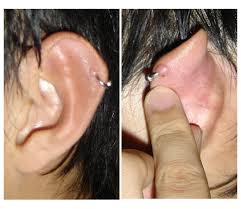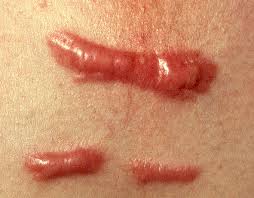Keloids are firm, rubbery lesions or shiny, fibrous nodules, and can vary from pink to the colour of the patient’s flesh or red to dark brown in colour. A keloid scar is benign and not contagious, but sometimes accompanied by severe itchiness, pain, and changes in texture. In severe cases, it can affect movement of skin. Keloid scars are seen 15 times more frequently in highly pigmented ethnic groups than in Caucasians. Read about Keloid- an outgrowth of scar repairing tissue
When skin is injured, fibrous tissue forms over the wound to repair and protect the injury. In some cases, scar tissue grows excessively, forming smooth, hard growths called keloids. Keloids can be much larger than the original wound, and are most commonly found on the upper chest and shoulders. However, keloids can affect any part of the body.
Some keloids disappear in course of time but some still spread and cause severe complications.
Table of Contents
Cause and preventive measures
The cause of keloid is genetic. If an individual in a family is suffering from keloids, there is a possible chance that any person who is genetically related to that individual may also have chances to be affected by keloids. Those individuals should take precautionary measures in order to avoid the formation of keloids. Following are the preventive measures
- Try to avoid any kind of scars on body.
- Keloid can appear on any part of the body, so avoid any piercing or casual cuts.
- Skin burnt should be avoided, these are the cause of many number of keloid cases.

- They can grow from a pimple, chicken pox scar, insect bites.
Signs and symptoms
Keloids grow by spreading from where they start. Due to the way they spread they cause discomfort and cosmetic concern. Pain is experienced on and around the keloid. Pain feeling is like pricking with a needle and burning sensation. It varies from person to person. When exposed to sun it becomes slightly dark.
Complications
Occasionally infection of keloids by mycoplasma is observed. It is seen by severe pain due to formation of pus. Mycoplasma infections may be difficult to cure. Antibiotics are used in a course to treat the infection.
Removal of the keloid by surgery
It is advised not to do any surgery since surgery itself causes cut in the skin and there is a lot of chance to grow another keloid at the cuts. But recently cryotherapy and laser surgery showed promising results as the re growth of keloids have been decreased in some cases.

